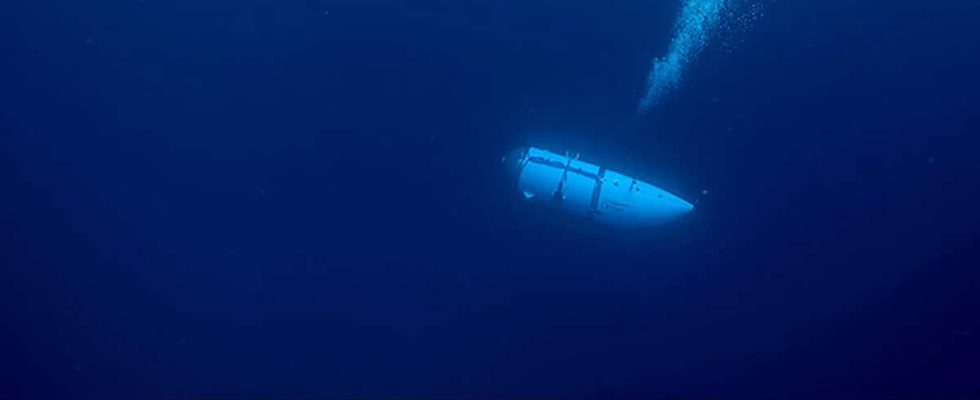The vast search operation in the North Atlantic enters a critical phase on Thursday to find a submersible and its five occupants missing near the wreck of the Titanic and whose oxygen reserves would be exhausted, according to the American Coast Guard.
• Read also – Submarine disappeared near the Titanic: a Quebecer had nevertheless sounded the alarm in 2018
• Read also – Missing submersible: how to interpret knocking sounds?
• Read also – Planes, boats, robots: the means deployed to search for the missing submersible
The US Coast Guard has announced it is continuing “rescue” operations of a submersible and its five missing occupants near the wreck of the Titanic, despite the feared depletion of oxygen supplies.
“We continue to see in particularly complex cases that people’s will to live really needs to be taken into account as well. And so we continue to search and continue our rescue efforts,” Rear Admiral John Mauger, head of search operations, told NBC.
AFP
The submersible has a theoretical autonomy of 96 hours in diving.
“We have to remain optimistic and hopeful,” US Coast Guard Captain Jamie Frederick said Wednesday during a press briefing in Boston.
Wednesday’s announcement of the detection of underwater noise by Canadian P-3 planes in the search area raised hope and directed the multinational armada of rescuers dispatched to the scene.
But “I can’t tell you what those noises are,” Captain Frederick said Wednesday after research by remotely operated underwater vehicles and a sonar-equipped surface vessel.
- Listen to Alexandre Dubé’s interview with Bertrand Sciboz, scuba diver specializing in the search for wrecks via QUB-radio :
Aerial surveillance using C-130 or P3 aircraft, ships equipped with underwater robots: the means deployed in particular by the American and Canadian armies continue to arrive at the site where the Polar Prince, the ship of which is stationed departed the submersible Titan.
A Canadian vessel with medical personnel and a decompression chamber is on its way.

AFP
The Atlante, a French Ifremer research vessel equipped with a robot capable of diving to the wreck of the Titanic, which lies nearly 4,000 meters deep, was to arrive on site around 08:00 GMT, according to the French research institute for the exploitation of the sea.
“The location of the research, 1450 km east of Cape Cod (on the Northeast coast of the United States, editor’s note) and 640 km south-east of Saint John of Newfoundland (in Canada) , makes it exceptionally difficult to mobilize large quantities of equipment quickly,” Captain Frederick explained.
The surface search area covers 20,000 square kilometres.
An American, a Frenchman, a Briton and two Pakistani-Britons dived into the abyss on Sunday morning aboard the Titan, a submersible designed for five people and about 6.5 meters long. He was expected to resurface seven hours later, according to the US Coast Guard.

AFP
Contact with the craft was lost less than two hours after its departure. Tuesday noon, the coast guard had warned that there were “about 40 hours of breathable air” on board.
Since the search began on Sunday, details implicating OceanGate have emerged, with the company being singled out for potential negligence in the safety of its underwater tourism device.
A 2018 complaint seen by AFP says a former company executive, David Lochridge, was fired after raising serious doubts about the safety of the submersible.
According to this former director of marine operations, a porthole at the front of the device was designed to withstand the pressure experienced at 1300 m depth, and not at 4000 m.
The boss of OceanGate, the American Stockton Rush, is aboard his Titan.
He dived alongside a wealthy British businessman, Hamish Harding (58), French Titanic specialist Paul-Henri Nargeolet (77)–nicknamed “Mr. Titanic”–, Pakistani tycoon Shahzada Dawood (48) and his son Suleman (19), who both also have British nationality.
For $250,000, they embarked on an exploration of the remains of what was one of the greatest maritime disasters of the 20th century.
The Titanic was wrecked on its maiden voyage in 1912 after colliding with an iceberg, killing nearly 1,500 passengers and crew.
Since the discovery of the wreck in 1985, scientists, treasure seekers and tourists have visited it, thus maintaining the myth.
“Every hour that passes is more agonizing,” founder and director of the Cité de la Mer in Cherbourg, western France, Bernard Cauvin, who worked with Paul-Henri Nargeolet, told AFP.
“I know his professionalism, including in crisis management. Psychologically and technically, he knows how to manage everything, he has experienced many others,” he added.
Tom Zaller, who visited the remains of the Titanic 23 years ago and leads a company putting on an exhibit on that boat in late June in Los Angeles, recalls a similar expedition in 2020 aboard a Russian ship equipped with two submersible.
“I took a camera and filmed myself. I looked at the footage later and was absolutely terrified,” he told AFP.
Tom Zaller has known Paul-Henri Nargeolet for a long time and had been in contact with Stockton Rush just before his departure on Sunday.
“They have been there for almost four days. I can’t imagine it,” he breathes. “I hope and pray that they get out of this and are found.”
